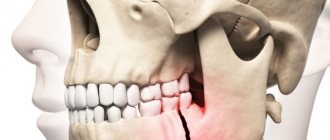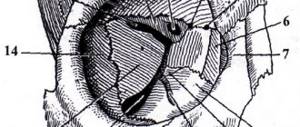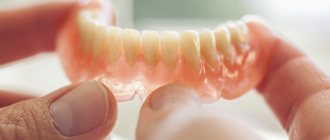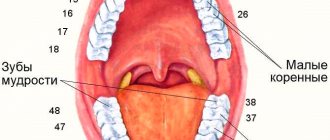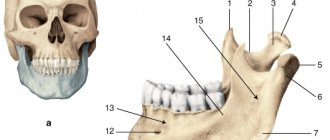A jaw fracture involves a violation of the integrity of the bone tissue; as a rule, it occurs suddenly due to external mechanical influence.
Statistics offer real figures; fractures of the facial bones of the skull account for no more than three percent of the number of fractures of other bones.
Regarding violations of the integrity of bone tissue in the cranial region alone, an impressive portion of about 80% are fractures of the lower jaw.
The lower jaw is designed in a certain way, which directly affects the nature of the bone tissue fracture.
An open fracture is characterized not only by a violation of the integrity of the soft tissues and mucous membranes in the oral cavity, but often, when passing through the jaw, a fracture or dislocation of the tooth root occurs, which is also an open fracture.
For this injury, jaw splinting is recommended. A panoramic photograph is first required to demonstrate the damaged area.
Only on the basis of the conclusion from the panoramic image, the doctor diagnoses a fracture of the jaw and prescribes splinting.
What will happen to the tooth at the site of injury?
A jaw fracture is a very unpleasant event. It is quite easy to determine whether there is a fracture of the jaw even before a panoramic image; the person is unable to open his mouth slightly, the bite is changed, there are visible tissue tears.
A jaw fracture often requires the removal of a tooth in the area where the injury occurred. You must understand that in some cases deletion can be avoided.
Let's try to clarify under what circumstances tooth extraction is required:
- if the fracture of the jaw touched a wisdom tooth, and the degree of damage to the tooth is not significant;
- the fracture occurred in a multi-rooted tooth, and the fracture directly passes between the roots;
- if the damaged tooth is very loose;
- if teeth that have inflammatory processes are affected, in particular there may be a cyst or granuloma;
- if the damaged tooth, according to the dentist’s indications, is subject to treatment;
- if correct reposition and fixation of fragments of a broken jaw is impossible without tooth extraction;
- in case of severe damage to the tooth, only if it is impossible to save it;
- a fracture of the jaw contributed to the dislocation of the tooth; the impacted tooth is also not recoverable.
The absence of other situations in the list above indicates that the tooth can be restored.
Feature of the technique
There are several methods for applying wire ligatures according to Ivey, Geikin and others.
However, immobilization of jaw fragments using splints is considered a more rational method compared to ligature binding, which is only a temporary procedure and is combined with the application of a chin sling. The Tigerstedt fixation method is considered universal, since it is used for almost all jaw bone fractures. For production, aluminum wire with a cross section of up to 2.0 millimeters is used.
The natural softness of aluminum allows structures to be made by hand. It does not require complex instrumentation, so the fixator can be customized for each patient and used in any setting.
This technique was modernized by domestic scientists A.A. Limberg and A.E. Rauer.
Splinting the jaw
Splinting for a fracture of the lower jaw is the only effective and correct method of treatment. The procedure involves joining the fragments into a single structure, as well as their complete fixation. The structure consists of either plastic components or wire.
Splinting the jaw for a fracture: x-ray photo
You must understand that if emergency assistance and transportation of the patient to a medical facility is required, then a splint should be applied as soon as possible; it may be necessary to tightly wrap the head with a bandage to secure the jaw.
In this situation, the main thing is to deliver the patient as quickly as possible to receive qualified assistance.
Kinds
The type of splinting is determined by the nature of the injury itself. There may be splinters or displacement in the bone tissue.
Today the following types of splinting are widely used:
- one-sided;
- two-way;
- two-jawed.
Now let's take a closer look at each of them.
When one-sided busbar is used, copper wire is used, which subsequently becomes the busbar.
The wire is attached using dental splinting directly to the damaged area. If there are teeth in the affected area, the splint is combined with a dental splint into a single, durable structure.
With double-sided splinting, fixation occurs on both sides. In this case, a wire is required that will be much stiffer than copper. If a more stable fixation is required, hooks or rings are installed.
Double jaw pinching is used for the most complex fractures, when in addition to a bilateral fracture there is a displacement.
If there are fixed teeth, copper wire is attached to them; if there are loose teeth, they are secured with a splint, drilling holes in the bone, after which both splints are connected into one complex structure.
Nature of the problem and types of disease
Jaw fracture is a concept used in traumatology to designate a number of pathologies, the cause of which is intense mechanical impact on the lower part of the face. Such damage is often associated with other injuries due to the complex influence of causes characteristic of almost all types of jaw injuries.
- angular, located in the area of the angle of the lower jaw;
- mental - in the area of the opening of the chin;
- canine - by location on the canine line;
- incisor - between the incisors;
- middle - along the dislocation between 2 middle incisors.
The fracture can be direct, located in the immediate place of impact, and indirect, which is located in the exact opposite place.
Open or closed, in the first case the soft tissues are torn or damaged, in the second only the bone structures are affected.
The nature of damage and deformation of bone fragments suggests division into several categories, in each of which up to 10 varieties can be counted:
- sagittal, vegetal, transversal fractures with displacement, in which bone fragments and parts of bones are displaced from their anatomical location in relation to their natural location or other bones
- complete, when a bone fragment protrudes in a transverse or oblique direction;
- splintered, extremely dangerous, in which bone fragments are dispersed in a chaotic disorder;
- a fracture without displacement, in which the bone is damaged, but remains in its usual anatomical location.
The healing of each of the above fractures, which, despite their diversity, invasiveness and degree of complexity, are united by one medical term, occurs at different times, and when compiling a recovery prognosis, many factors that can influence this process are taken into account. The time during which a fracture heals can be completely different, even in the same cases, if there have been complications or associated injuries.
Materials used
Currently, there is a large selection of materials that can be used for splinting. Each experienced doctor has his own set of favorite materials with which he is accustomed to working and achieves a certain result.
Splinting with fiberglass
But we must understand that materials are selected depending on the degree of injury, as well as the individual characteristics of the patient. What helps one patient will not always save another. Therefore, the selection of special materials is carried out by the attending physician.
The list of popular materials for splinting includes metal wires, plastic parts, fiberglass tapes, rubber bands for fixation, and metal hooks or rings.
Symptoms
Treatment of a jaw fracture occurs if the following symptoms are present:
- pronounced pain;
- immobilization of the jaw, a sound characteristic of a fracture (clicking) and increased pain when opening the mouth;
- perhaps a visually noticeable displacement, curvature of the jaw;
- in some episodes, numbness of the fracture site is felt, this occurs when the nerve endings are torn or ruptured;
- there is a rupture of nearby tissues;
- headache and dizziness.
Certain symptoms indicate injury to the facial bones. They are visible or felt by the victim:
- Hemorrhage and swelling of the damaged area, which gives asymmetrical facial features.
- Pain on palpation, aggravated by mouth movements.
- Malocclusion.
- Displacement of broken parts of the jaw.
Depending on the location of the fault, injuries may include:
- in the center of the incisors - median;
- in the canine area – canine;
- between the first incisor and the lateral ones - incisive;
- along the chin - mental;
- behind the 8th tooth – angular;
- upper third - fracture of the branch;
- bases of the condylar process;
- in the area of the condylar process - cervical;
- in the area of the coronoid process - coronary.
- in the center of the incisors - median;
- in the canine area – canine;
- between the first incisor and the lateral ones - incisive;
- along the chin - mental;
- behind the 8th tooth – angular;
- upper third - fracture of the branch;
- bases of the condylar process;
- in the area of the condylar process - cervical;
- in the area of the coronoid process - coronary.
Accurate diagnosis of the fracture, its type and severity determine further treatment.
Symptoms indicating a violation of the integrity of the jaw bones are quite extensive. They can be identified visually, as well as by the sensations of the victim. Quite often, a fracture is accompanied by a traumatic brain injury and loss of consciousness, so it is very important to receive timely, qualified medical care.
The symptoms of a jaw fracture are quite varied. In most cases, this pathology is combined with a number of external manifestations, as well as a number of subjective sensations.
However, since quite often a fracture of the jaw is combined with traumatic brain injuries, in which the victim may be unconscious, those clinical manifestations that the doctor can see during examination are of greatest importance.
We invite you to familiarize yourself with a mouthguard for boxing: how to choose and properly “cook” dental protection
Treatment tactics
First aid for a jaw fracture involves the immediate administration of a painkiller and disinfection of the affected area, after which it is possible to reposition the jaw fragments.
Next, a strong fixation of the broken bone is required; individual splinting of the jaw literally sews up the mouth. After installing the splint, you need to secure the ligature and tighten it if necessary.
To avoid unpleasant consequences when splinting a jaw for a fracture, a course of antibiotics can be prescribed throughout the treatment to get rid of possible infections.
Constant monitoring by the attending physician is mandatory for such injuries. The examination includes a visual inspection, checking the fixation structure, as well as washing the vestibule of the mouth with a special antiseptic solution. Much attention is paid to the condition of the bite. Updated x-rays are required once a week to monitor bone restoration.
After the splints are removed, the patient goes through a long recovery phase, during which he literally learns to eat and speak again. For another month, the patient should have a gentle diet, with the gradual addition of new products. With daily gymnastics, positive dynamics are observed within a month.
When are tires removed?
Many who have encountered this unpleasant situation are wondering when the tires will be removed.
The question is very complex, since it completely depends on the nature of the injury and the individual speed of recovery of the body.
It is quite possible that the splints can be removed a month after the injury or a year later.
Only the attending physician, based on the latest X-ray images and if the patient’s condition is satisfactory, has the right to prescribe removal of the fixation structure.
How long does it take for a jaw to heal?
No specialist can answer this question accurately, since the question is extremely individual.
Recovery time depends not only on the severity of the fracture, but also on the quality of treatment.
Recovery often takes 3 to 4 weeks, after which the person is fully restored within another month.
If we talk about serious fractures that are associated with numerous fragments and displacements, then in this case the time frame can increase to a year, even with treatment and good care.
In order to fully recover from an injury, you also need to take gymnastics courses that can restore the activity of muscles and joints to the fullest extent.

